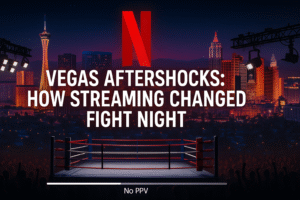When Terence Crawford dismantled Canelo Álvarez in Las Vegas, the biggest upset wasn’t only in the ring. It was on the balance sheet. By folding a mega-fight into a standard streaming subscription—no pay-per-view add-on—Netflix reframed how prizefights are financed, distributed, and measured. The ripple effects will shape the next decade of boxing business.
The model: subscription beats the PPV wall
For three decades, boxing’s revenue engine was simple: sell as many $80–$100 pay-per-views as possible and make everything else—sponsorships, gate, international rights—support that engine. Netflix flipped the script.
- Frictionless access. Putting a superfight behind a login instead of a paywall turns the casual fan into a viewer with one click. Lower friction means larger, more global reach.
- Engagement over receipts. The success metric moves from “units sold” to “minutes watched.” That aligns with how streamers evaluate content—and how brands buy media.
- Whole-platform packaging. Pre-fight documentaries, shoulder programming, the main event, and replay highlights can all live under one roof. Viewers binge the story, not just the bout.
Claimed numbers vs. consistent skepticism
Streaming audiences are huge, but the way they’re counted is different from traditional TV or PPV. Average-minute audience, peak concurrency, households reached—each tells a slightly different story.
- The headline is scale. However you slice the metrics, a no-PPV, all-subscriber distribution can attract an audience that dwarfs typical U.S. PPV buys.
- Apples-to-apples is tricky. Expect promoters, broadcasters, and analysts to continue arguing over definitions—and expect streamers to emphasize the measures that best reflect sustained engagement.
- Perception still matters. Fighters and promoters care about how “big” a night feels. If sponsors and fans treat these events as the new Super Bowl of the sport, that perception translates into real leverage for future negotiations.
Why promoters and brands should care
1) Bigger, more measurable reach.
A global stream multiplies the top-of-funnel. With an ad-supported tier and precise targeting, brands can buy against demographics and regions instead of guessing at PPV buyer profiles. For promoters, this visibility helps build future stars faster.
2) New revenue stacking.
If the PPV ticket shrinks or disappears, money doesn’t vanish—it shifts. Expect deeper brand integrations, ad inventory, placement in pre/post-fight content, and international sublicensing to become the primary levers. The fighter who carries a docu-series into fight week now brings extra inventory to sell.
3) Piracy pressure drops.
Lowering the pay barrier reduces the incentive to steal feeds. Cleaner distribution improves sponsor confidence and raises the effective value of every impression.
4) Event → ecosystem.
On a streamer, fight night isn’t a single three-hour window. It’s a multi-week content arc: announce → camp updates → countdown → live event → instant replays → evergreen highlights. That gives brands more touchpoints and gives fighters longer storytelling runways.
How matchmaking could change
When subscribers, not one-night buyers, are the core audience, the incentives shift.
- Crossover matters. Fights with cultural gravity—charismatic A-sides, national pride angles, or styles that casual fans understand—become more valuable than sanctioning-body mandatories that only purists follow.
- Fewer “keep-busy” cards at the top. Streamers will favor fewer, larger tentpoles with blockbuster packaging, cinematic production, and stacked undercards that justify campaign-length promotion.
- Year-round narratives. Expect more embedded series, gym features, and personality-driven content that can turn contenders into must-watch headliners months before a belt is on the line.
What it means for the old guard
Traditional PPV and premium cable won’t evaporate overnight, but they’ll have to adapt.
- Hybrid pricing. Lower-priced PPVs, bundles, or ad-supported simulcasts will try to recapture casuals who wouldn’t have bought at full freight.
- Co-rights and co-promotions. To match streaming scale, networks may share rights or co-produce shoulder programming, especially for international distribution.
- Data deficit. Legacy players have less granular viewer data. Streamers owning the customer relationship—and the watch-time dataset—gives them a negotiation edge.
The Saudi variable
Deep-pocket backers who already underwrite heavyweight extravaganzas love scale and spectacle. A streamer’s global reach, paired with sovereign or state-backed site fees, creates the quickest path to “can’t-miss” nights. Expect more cross-promotional cards, undisputed-title consolidations, and unification bouts that are easier to greenlight when a single platform can promise worldwide distribution.
What fighters should do next
- Build media, not just muscle. Invest in personality-driven content months out. Your camp vlog might be as important to your purse as your southpaw counter.
- Negotiate beyond the ring. Ask for participation in shoulder programming, replay windows, and international promos. Those are real assets now.
- Think global. Multi-language clips, regional press days, and social creators abroad matter when a third of your audience might be waking up in another time zone.
What brands should do next
- Buy the arc. Don’t just sponsor the corner stool on fight night. Book the countdown series, the weigh-in set, the locker-room cam, and the next-day highlights.
- Plan creative for clips. Most exposure will live in short-form replays. Design logos and reads that survive cropping and vertical video.
- Measure like a streamer. Optimize for completed views, watch time, and lift in branded search—then push retargeting while the narrative is hot.
Bottom line
Netflix didn’t only air a fight—it rewired the incentives around one. By swapping PPV receipts for platform-wide reach and engagement, the company showed that boxing’s biggest nights can be even bigger when the door is open to everyone already inside the app. Promoters, fighters, and brands that adapt to this ecosystem—where stories are longer, audiences are broader, and value is counted in minutes watched—will own the next era of fight night.

